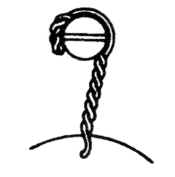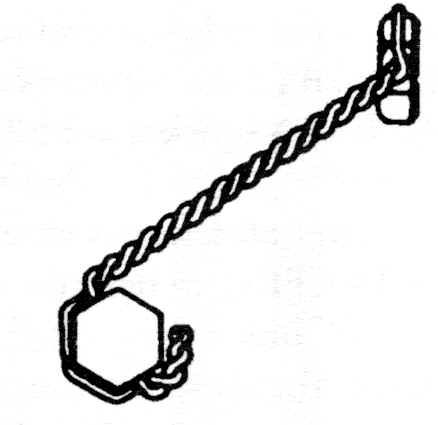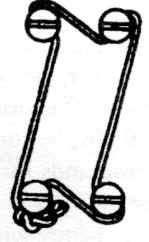|
In ultralight aviation
there are three things that I have learned you can't be without.
Velcro, duct tape, and SAFETY WIRE. This article is about the
latter, Safety Wire.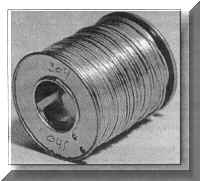
I have had a couple of
rolls of the stuff around here for years. It comes in several
different thickness, for different applications. It is cheap, very
light, corrosion resistant, strong, and easy to install.
I first ran into "aircraft safety wire" at Sun N Fun in
1980, I bought 3 different spools - .020/.032/.041 and I still
have all of them sitting in the top of the tool box next to the
installation pliers. Back then they cost me about $5 bucks a roll
- last year I was pricing them and they now cost about $9. each.
But 1 roll will do the average guy a lifetime!
.020
is very thin, not very strong, but you can bend it around just
about anything. You use it to safety wire light bolts or fittings
where you need to bend the wire around a lot of
corners, and where the wire does not have a lot of pull on it.
.041
is extremely strong, because it is twice as thick and is
very stiff, and difficult to work with. It doesn't bend
easily and won't tighten around tight radius, you use it on wide radius turns where high strength
requires the extra effort to use it.
.032
is what I use the most - and ran out of first! If I was
shopping for a spool of safety wire this would be what I would
recommend. It is easier to work with, and reasonably strong
and should work on anything you might need to use safety wire on an
ultralight.
While
there are different materials used to make safety wire, brass an
aluminum, I don't recommend them. The type I recommend is 302/304
soft temper stainless s teel. teel.
One
of the things I quickly learned especially with the thicker wires
is that a safety wire tool makes the job a lot faster and easier.
T here
are several different tools ranging from a unit that looks like a
screw driver, to a wire winder
tool, to a safety pliers. For a
klutz like me these make a beautiful finished job, with the right
tightness and strength. here
are several different tools ranging from a unit that looks like a
screw driver, to a wire winder
tool, to a safety pliers. For a
klutz like me these make a beautiful finished job, with the right
tightness and strength.
They are easy to use. I have the pliers type shown at right. You
wrap the safety wire around whatever it is you are securing, bring
both ends back into the pliers mouth, close the mouth down on the
wires, lock it (it has a little spring loaded locking mechanism)
then pull a round knob in the middle of the handle back - a lot
like those spinning tops we use to get as a kid. You know the ones
that you pumped up and down and the top would spin for what seemed
like hours! Am I dating myself here? Anyways when you pull on the
knob the plier handles turn and the wire wraps around itself.
Areas
where you might use safety wire include around bolt heads, or nuts
where there is not means of locking them. Areas of special concern
are prop bolts, control system linkages, areas of movement, or
vibration. Another area of use is on turnbuckles to prevent them
from backing off in flight.
Several years ago I forgot to safety
wire the turn buckle on the cable operating the elevator on my
L'il Buzzard. About three hours into a cross country flight I
noticed that the stick movement was very sloppy and loose. A check
of the cable revealed the turn buckle had backed off 3/4's of the
threads in just 3 hours.
Other
areas that I use safety wire are:
-As hose clamps around the fuel lines, fuel pump, carb, primer
bulb. Using the pliers it is easy to use the .032 wire. I wrap it
around the hose two or three times then bring it back to the
pliers. Presto you have a clamp that is cheap, effective, and easy
to remove.
-As
replacements for the older style EGT probe clamps. I have been
doing this for years, after the one of the clamps broke off and
went through my prop. You wrap two or three wraps around the
probe, place the probe into the hole in the manifold, (you may
have to use a couple of washers to space the probe out so it does
not touch the other side of the manifold) then wrap each end of
the safety wire around the exhaust manifold a couple of times - then bring
the two wires together and hook them into your pliers, and pull. (.040)
-On
the 53/582 you won't find a clamp small enough to go around the
vent on the top of the cylinder head (water pump outlet on
inverted engines) two or three wraps of safety wire does the
trick. (.032)
-On
the exhaust springs. Run a piece of safety wire through the center
of the spring, onto the spring hook then back through the center
to the other spring hook, use your pliers to tighten. THEN fill
the spring FULL of silicone.
-On
the rotary valve tank cap. If you look you will see that the cap
has a little hole in it at the bottom of the threads. Hook a piece
of safety wire though it and then secure it to the little tab on
the rotary valve tank. That's what it's there for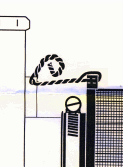
-To
secure your airfilters to your carbs. If you check out the alert
bulletins on site, and the accident statistics you will find a
number of instances where the airfilters have come off and gone
through the prop.
-Secure
spark plug caps to spark plugs, especially in inverted engine
installations like the Challenger.
-Secure
the carb nuts and studs on the 185 Rotax engine used on the Lazair
ultralight. They had a tendency to vibrate out, so we would drill
a hole in the stud and nut then safety wire it back onto the carb
to stop them from turning.
Of
course the main area that you will find safety wire used in on
prop bolts. In fact it was the first thing that a conventional
pilot pointed out to me on my Challenger, the bolts in the prop
hub weren't secured and could vibrate and back out. This
results in a loose fitting prop which shears the prop bolts!
On
my old Buccaneer I replaced the little rings on the rudder control
pins with safety wire when one of them came off in flight after I
taxied through some mud and weeds.
A
bolt that is properly safety wired like that on the right just doesn't just hold the fastener in place, it serves to
pull it tighter. Each bolt holds the other and actually tightens the
other if it starts to come loose.
How
to Properly Install Safety Wire
There
are a couple of basic rules to follow when safety wiring
something.
They are:
-If
you are safety wiring a nut or bolt FIRST torque the nut or bolt
to its proper torque. Where possible align the holes that are
going to be used to safety wire the units in place. BUT DON'T OVER
TORQUE or UNDER TORQUE them to achieve this!
-After
installation the safety wire should be tight! So as not to allow
the unit(s) to move.
-Safety
wire should always be installed so as to make the nut or bolt
"TIGHTEN" itself when the safety wire has been
installed. That is the safety wire should come around the top of
head of the bolt/nut and back onto the securing unit so that the
safety wire PULL is in a tightening direction!
-NEVER
over stress the safety wire. This weakens it, which could cause it
to break under vibration or load. This is generally caused when
you "over wind" the safety wire. Safety wire should
never be nicked, or kinked.
When cutting the safety wire always
leave 4 to 6 turns after the loop. REMEMBER always bring the
safety wire AROUND the head of the bolt/nut in a tightening direction, in as small a contour to the bolt/nut as you can get.
A
Klutz's guide to using a set of safety wire pliers!
After
you have wrapped the safety wire around the object, grip both ends
of the wire in the jaws of the safety wire pliers and slide the outer sleeve down with your thumb to lock
the handles.
Now
grasp the knob located in the middle of the pliers and gently pull
out. This will cause the plier handles to turn, twisting the
safety wire!
When
you have the amount of twists required, grasp the handles and
squeeze. This will release the safety wire from the jaws of the
pliers.
Use
the cutters in the jaws to cut the safety wire to the proper
length, then bend the end of the wires over so that you don't poke
yourself on them the next time you reach into work on
something.
Securing
the rotary valve tank cap on a 532/582 Rotax engine.
Find the hole in the cap, it is at the bottom of the threads in
the cap. Run a piece of safety wire through it, and pull it back
out so you have about 6 inches of safety wire.
Move down to about
an inch from the pliers end of the safety wire. Hook the pliers up
to the safety wire and twist until you have a nice spiral coming
up to the pliers. Install you cap onto the rotary valve tank.
Now
wrap the safety wire around the tank - in a tightening direction
and connect it to the little standoff on the rotary valve tank.
Hook one end of the wire through the standoff, grab both wires
with the safety wire pliers and twist gently. You don't want to
have too many loops incase you have to take the cap off.
|



 teel.
teel. here
are several different tools ranging from a unit that looks like a
screw driver, to a wire winder
tool, to a safety pliers. For a
klutz like me these make a beautiful finished job, with the right
tightness and strength.
here
are several different tools ranging from a unit that looks like a
screw driver, to a wire winder
tool, to a safety pliers. For a
klutz like me these make a beautiful finished job, with the right
tightness and strength.







